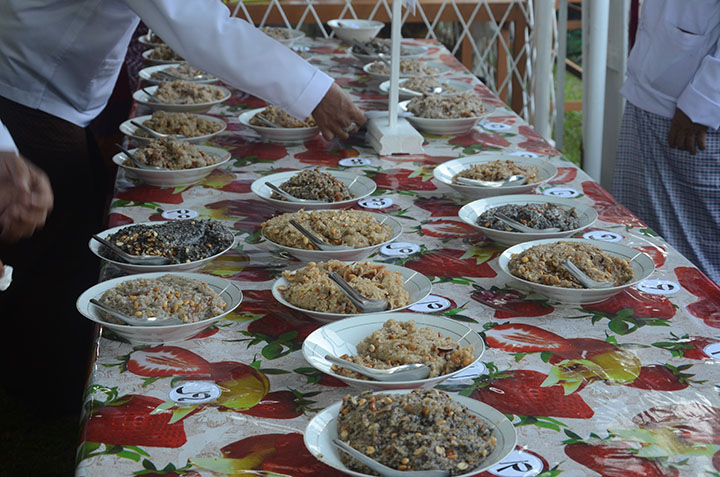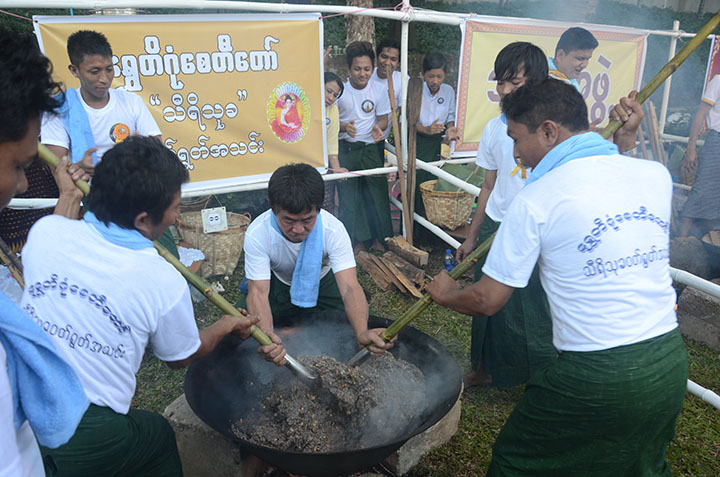By Maha Saddhamma
Jotika Dhaja, Sithu
Dr. Khin Maung Nyunt
Tabodwe the eleventh month of Myanmar Lunar Calendar of 12 months is spelt and its meaning is interpreted different in Myanmar literary history. Most outstanding examples are two. Firstly it was spelt ထမ်းပိုးတွဲ [Yoke hung]. In this month all field and farm agricultural activities are over. Therefore yokes are at rest. They are hung at the houses. So it is the month of yoke being hung. Secondly, Toddy palm trees which grow wild or are planted across the country are very useful. Every part of a toddy palm tree is used in building, roofing, making domestic furniture and human facilities- mats, baskets sun shades etc. Its fruits, juice and shells are eaten raw or boiled down to get balls of sugar called htan-nyet [gagary] the fresh juice is drunk for hygine and fermented juice is drunk as liquar. Fermented toddy juice is as intoxicating as or more than Scotch whisky.
The second name of the month is Htan but-we ထန်းဖူးတွဲ [the bunch of tender tooly fruits is pressed down so as to collect drops of its juice in the container earthen pot htan yey oh (ထမ်းရေအိုး) specially made for this purpose. The toddy climber ထမ်းတက်သမား is the only one who is well trained by daily usage to carry a ladder, the pot and a sharp knife to the job early morning to noon time. He presses down with his legs the bunch of tender toddy fruits right on the month of toddy juice earthen pot. So in this month bunches of toddy fruits are pressed down to remain hanging. Here the name ” ထန်းဖူးတွဲလ”.
In Myanmar there are some rhymed couplets to describe the outstanding nature of every month or year. နှာရည်ယိုတွဲ၊ တပို့တွဲ၊ ဇီးဝမ်ပေါက်ကွဲ တပို့တွဲ၊ မီးပုံဆင်နွှဲ တပို့တွဲ and ထမနဲထိုးပွဲတပို့တွဲ၊ loosely translated into English. In Dabodwe we have running nose. In Dabodwe, wild plum fruits are ripen open. Bonfire festival in Tabodwe and concocting htamane delicacy festival in Tabodwe.

Of the above rhymed couplets, Bonfire festival မီးပုံဆင်နွှဲ တပို့တွဲ၊ should be explained first. Traditionally celebrated festival in this month is the bonfire festival. Its history goes back to the life time of Lord Gotama Buddha. While residing at a Vihara [Monastery] close to the Himalayan Mountain Ranges. Buddha felt extreme cold of one winter night. He used all three robes to get warmth. As the night advanced, the three robes could not protect Lord Buddha from cold. As Vinaya [Priestly Disciplines] do not allow more than three robes to wear, he made a fire to get warmth when day broke, cold was more intense. Luckily the Sun came out. So he stayed in the sunshine to get warmth.
Myanmar Buddhists offered bonfire for warmth on an earthen circular open container မီးလင်းဖို to Buddha statues, old monks and the aged parents or relatives to provide warmth. So the traditional festival of this month is bon-fire [for warmth] offering festival on the full moon night of this month. It is believed that only after this festival, cold is reduced.
The festival of concocting Myanmar delicacy Htamane [ထမနဲ] is also quite a festive activity of Myanmar people. It is in fact one of Myanmar New Crop Consuming Festivals [ကောက်သစ်စားပွဲ] which all Myanmar ethnic nationalities hold and celebrate at their villages in their own traditional manner.
Htamane concoction is a communal activity in which Myanmar people of all age groups have to participate. Both males and females of old age, middle age, Young ages including children are involved. The old age people supervise the work and judge whether the concoction of delicacy is up to the standard. The middle age people organize the concoction party, make division of labour and give the recipe [formula] of making the delicacy lend pots pans and instruments from their our possession at home or from the monasteries.
Males of young age group do the hard work making fire places, bringing down coconut fruits making big fire place, concocting the delicacy with strong long wooden spoon with their muscular hands. Females of young age group do the cleaning, washing glutinous rice, shedding coconut, frying incredients such as peanuts sesamum, garlic and onion and ginger, which they spray on the glutinous rice in the big iron pan. Children gather banana leaves for packing the delicacy or spread them on the circular table to put the delicacy to serve allcomers from all directions, known or unknown, native or foreigners, friends or strangers.
When the judges examine the concocted delicacy they make three standards the best, better and good. Lumps of delicacy are put on banna leaves on the table. First to offer to three Jewels the Buddha, the Dhamma and the Sanghas. Next to the Aged, Parents and Teachers. Finally it is a free for all to enjoy. After you enjoy the delicacy to your hearts’ content or full capacity of your belly, you can take away the banana packed delicacy. Good htamena delicacy can last long.
Myanmar traditional medicine men highly recommend all age groups to eat the delicacy in winter. Body skin dries up due to extreme cold. You need oil to heal your dried skin. Htamena delicacy gives you oil to heal your dried skin. The recipe of making htamane delicacy is in the form of the following rhymed poetic lines called Tay-htat တေးထပ်. For lack of space the writer withholds reproducing it in Myanmar. He gives his loose English translation.
“Take 4 pyi from a basket of nice glutinous rice and wash them clean with fresh water. Put one viss of pure sesamum oil in a big iron pan which is placed on a wood fire, fry 3 ticals weight of ginger slices in the oil and stir it thoroughly. Add some water to it and knead with big long wooden ladles. When the glutinous rice gets grilled with oil oozing out of it reduce the fire. Spray on the glutinous rice in the pan 80 ticals weight of fried ground nuts, 32 ticals weight of roasted sesemum seeds, 20 ticals weight of shredded coconut kernel, and 7 ticals weight of salt are sprayed on the stuff.
Then knead, press and crush the stuff in the pan again and again with long wooden ladles by muscular hands of young men. Taste it to test if the stuff has attained the standard quality. If so, the htamane delicacy is put on the banana leaves, ladleful by ladleful”.
Preparation of htamane provides a social occasion for Myanmar Community. If contest is held, the winner partings will make a jubilant round of rejoice of their victories with music dance and songs in the compounds of monasteries or precincts of Pagodas. Sometimes even old aged participate in such rejoicing activities. Universities, Colleges and schools used to hold such kind of communal activities, in which both teachers and students of all ethnic nationals of all religious faiths merrily participate.



